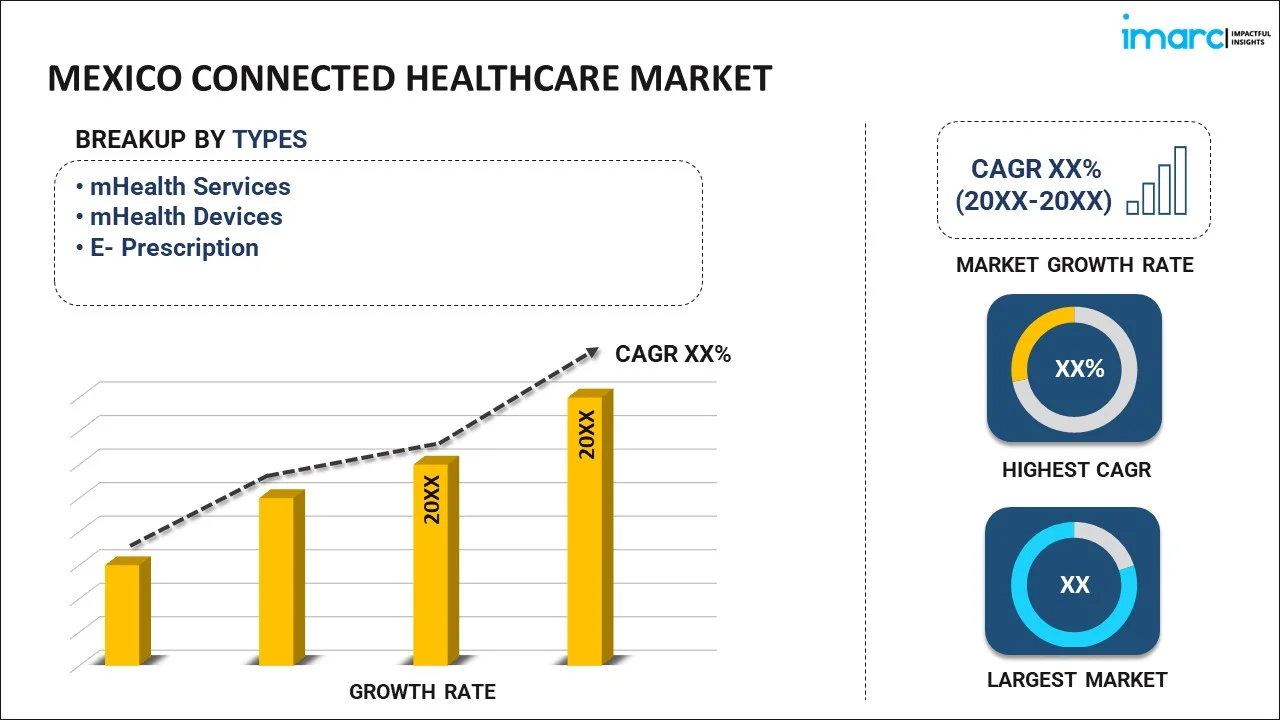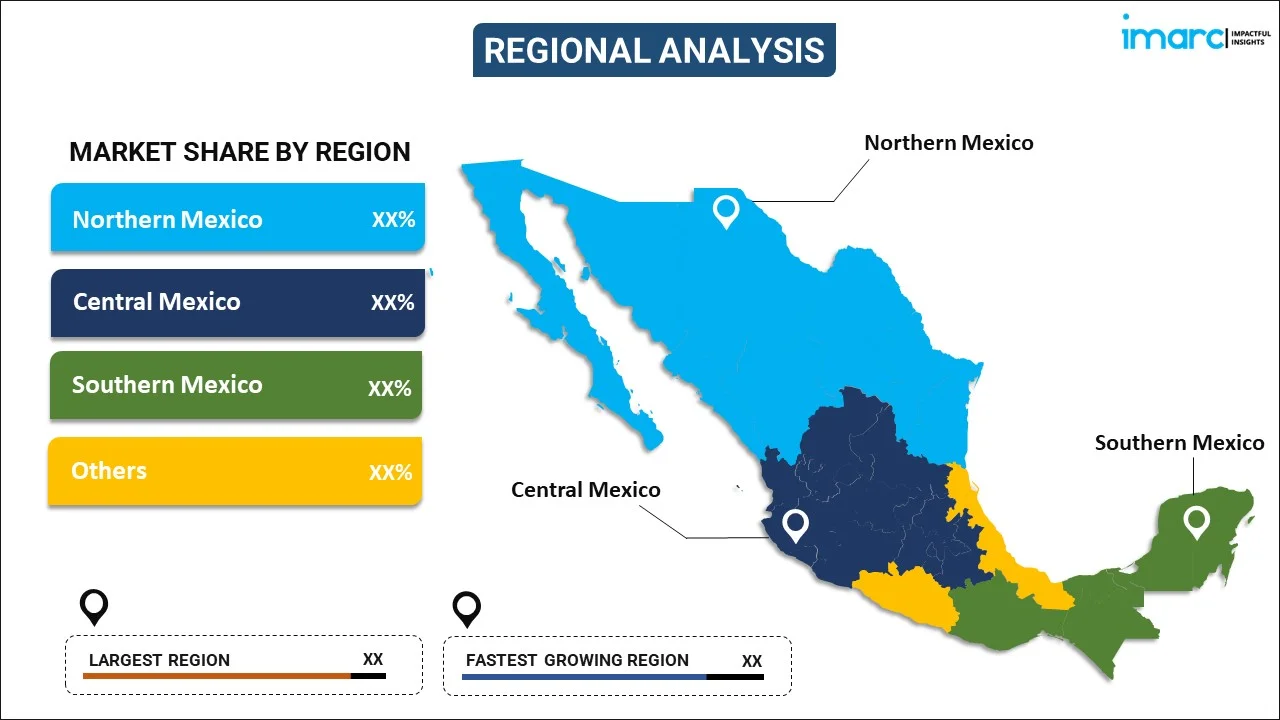
Mexico Connected Healthcare Market Report by Type (mHealth Services, mHealth Devices, E- Prescription), Function Type (Remote Patient Monitoring, Clinical Monitoring, Telemedicine, and Others), Application Type (Diagnosis and Treatment, Monitoring Application, Wellness and Prevention, Healthcare Management, and Others), and Region 2025-2033
Market Overview:
Mexico connected healthcare market size reached USD 1,595.6 Million in 2024. Looking forward, IMARC Group expects the market to reach USD 10,586.4 Million by 2033, exhibiting a growth rate (CAGR) of 22.23% during 2025-2033. The increasing demand for remote patient monitoring, which allows healthcare providers to track vital signs and health metrics outside traditional healthcare settings, leading to timely interventions and improved patient outcomes, is primarily driving the regional market.
|
Report Attribute
|
Key Statistics
|
|---|---|
|
Base Year
|
2024
|
|
Forecast Years
|
2025-2033
|
|
Historical Years
|
2019-2024
|
|
Market Size in 2024
|
USD 1,595.6 Million |
|
Market Forecast in 2033
|
USD 10,586.4 Million |
| Market Growth Rate 2025-2033 | 22.23% |
Connected healthcare refers to the integration of technology and digital solutions to enhance the delivery and management of healthcare services. It encompasses a network of interconnected devices, applications, and systems that facilitate seamless communication and data exchange between healthcare providers, patients, and various stakeholders. This interconnected ecosystem enables real-time monitoring, remote patient management, and efficient sharing of medical information, ultimately leading to more personalized and proactive healthcare. Examples include wearable devices that track vital signs, telemedicine platforms for remote consultations, and electronic health records for centralized patient information. Connected healthcare aims to improve accessibility, streamline workflows, and enhance overall healthcare outcomes by leveraging the power of connectivity and data-driven insights.
Mexico Connected Healthcare Market Trends:
The connected healthcare market in Mexico is experiencing significant growth, driven by a multitude of factors that are reshaping the healthcare landscape. Firstly, the increasing adoption of Internet of Things (IoT) devices in the healthcare sector is playing a pivotal role. These devices enable real-time monitoring of patient's health, providing healthcare professionals with valuable data for proactive and personalized care. Additionally, the growing prevalence of chronic diseases is propelling the demand for remote patient monitoring solutions, fostering the expansion of the connected healthcare market. Moreover, the rise of telemedicine is a key driver, connecting patients with healthcare providers through virtual platforms. This not only enhances accessibility to healthcare services but also reduces the burden on traditional healthcare infrastructure. Furthermore, the emphasis on interoperability and integration of healthcare systems is facilitating seamless communication and data exchange among different healthcare stakeholders. This interconnected approach ensures a comprehensive and cohesive healthcare ecosystem. Furthermore, advancements in artificial intelligence (AI) and machine learning are driving innovation in healthcare analytics, enabling better decision-making and predictive analytics. As the demand for efficient and data-driven healthcare solutions escalates, the regional connected healthcare market continues to flourish, driven by these interconnected trends that collectively contribute to the transformation of healthcare delivery.
Mexico Connected Healthcare Market Segmentation:
IMARC Group provides an analysis of the key trends in each segment of the market, along with forecasts at the country level for 2025-2033. Our report has categorized the market based on type, function type, and application type.
Type Insights:

- mHealth Services
- mHealth Devices
- E- Prescription
The report has provided a detailed breakup and analysis of the market based on the type. This includes mhealth services, mhealth devices, and e- prescription.
Function Type Insights:
- Remote Patient Monitoring
- Clinical Monitoring
- Telemedicine
- Others
A detailed breakup and analysis of the market based on the function type have also been provided in the report. This includes remote patient monitoring, clinical monitoring, telemedicine, and others.
Application Type Insights:
- Diagnosis and Treatment
- Monitoring Application
- Wellness and Prevention
- Healthcare Management
- Others
The report has provided a detailed breakup and analysis of the market based on the application type. This includes diagnosis and treatment, monitoring application, wellness and prevention, healthcare management, and others.
Regional Insights:

- Northern Mexico
- Central Mexico
- Southern Mexico
- Others
The report has also provided a comprehensive analysis of all the major regional markets, which include Northern Mexico, Central Mexico, Southern Mexico, and Others.
Competitive Landscape:
The market research report has also provided a comprehensive analysis of the competitive landscape in the market. Competitive analysis such as market structure, key player positioning, top winning strategies, competitive dashboard, and company evaluation quadrant has been covered in the report. Also, detailed profiles of all major companies have been provided.
Mexico Connected Healthcare Market Report Coverage:
| Report Features | Details |
|---|---|
| Base Year of the Analysis | 2024 |
| Historical Period | 2019-2024 |
| Forecast Period | 2025-2033 |
| Units | Million USD |
| Scope of the Report | Exploration of Historical Trends and Market Outlook, Industry Catalysts and Challenges, Segment-Wise Historical and Future Market Assessment:
|
| Types Covered | mHealth Services, mHealth Devices, E- Prescription |
| Function Types Covered | Remote Patient Monitoring, Clinical Monitoring, Telemedicine, Others |
| Application Types Covered | Diagnosis and Treatment, Monitoring Application, Wellness and Prevention, Healthcare Management, Others |
| Regions Covered | Northern Mexico, Central Mexico, Southern Mexico, Others |
| Customization Scope | 10% Free Customization |
| Post-Sale Analyst Support | 10-12 Weeks |
| Delivery Format | PDF and Excel through Email (We can also provide the editable version of the report in PPT/Word format on special request) |
Key Questions Answered in This Report:
- How has the Mexico connected healthcare market performed so far and how will it perform in the coming years?
- What has been the impact of COVID-19 on the Mexico connected healthcare market?
- What is the breakup of the Mexico connected healthcare market on the basis of type?
- What is the breakup of the Mexico connected healthcare market on the basis of function type?
- What is the breakup of the Mexico connected healthcare market on the basis of application type?
- What are the various stages in the value chain of the Mexico connected healthcare market?
- What are the key driving factors and challenges in the Mexico connected healthcare?
- What is the structure of the Mexico connected healthcare market and who are the key players?
- What is the degree of competition in the Mexico connected healthcare market?
Key Benefits for Stakeholders:
- IMARC’s industry report offers a comprehensive quantitative analysis of various market segments, historical and current market trends, market forecasts, and dynamics of the Mexico connected healthcare market from 2019-2033.
- The research report provides the latest information on the market drivers, challenges, and opportunities in the Mexico connected healthcare market.
- Porter's five forces analysis assist stakeholders in assessing the impact of new entrants, competitive rivalry, supplier power, buyer power, and the threat of substitution. It helps stakeholders to analyze the level of competition within the Mexico connected healthcare industry and its attractiveness.
- Competitive landscape allows stakeholders to understand their competitive environment and provides an insight into the current positions of key players in the market.
Need more help?
- Speak to our experienced analysts for insights on the current market scenarios.
- Include additional segments and countries to customize the report as per your requirement.
- Gain an unparalleled competitive advantage in your domain by understanding how to utilize the report and positively impacting your operations and revenue.
- For further assistance, please connect with our analysts.
 Inquire Before Buying
Inquire Before Buying
 Speak to an Analyst
Speak to an Analyst
 Request Brochure
Request Brochure
 Request Customization
Request Customization




.webp)




.webp)












